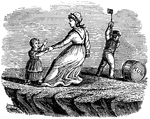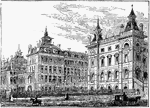Clipart tagged: ‘cure’

Feverfew
Feverfew (Tanacetum parthenium; syn. Chrysanthemum parthenium) is a traditional medicinal herb which…

Prevention is Better than Cure
"The child is wandering into danger great, / The mother draws it from a downward fate, / Thus stops…

St. Thomas's Hospital
The hospital was described as ancient in 1215 and was named after Thomas Becket — which suggests it…